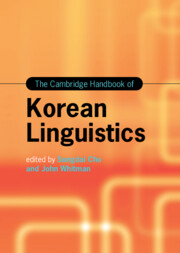Book contents
- The Cambridge Handbook of Korean Linguistics
- Cambridge Handbooks in Language and Linguistics
- The Cambridge Handbook of Korean Linguistics
- Copyright page
- Contents
- Figures
- Tables
- Contributors
- Preface
- Acknowledgments
- Abbreviations
- Part I Korean Overview
- Part II Phonetics and Phonology
- Chapter 7 Vowel Harmony
- Chapter 8 The Phonology and Phonetics of Korean Stop Laryngeal Contrasts
- Chapter 9 The Phonetics-Prosody Interface and Prosodic Strengthening in Korean
- Chapter 10 Constituent Structure and Sentence Phonology of Korean
- Chapter 11 Effects of Linguistic Experience on the Perception of Korean Stops
- Part III Morphology and Syntax
- Part IV Semantics and Pragmatics
- Part V Sociolinguistics and Psycholinguistics
- Part VI Language Pedagogy
- Index
- References
Chapter 9 - The Phonetics-Prosody Interface and Prosodic Strengthening in Korean
from Part II - Phonetics and Phonology
Published online by Cambridge University Press: 30 September 2022
- The Cambridge Handbook of Korean Linguistics
- Cambridge Handbooks in Language and Linguistics
- The Cambridge Handbook of Korean Linguistics
- Copyright page
- Contents
- Figures
- Tables
- Contributors
- Preface
- Acknowledgments
- Abbreviations
- Part I Korean Overview
- Part II Phonetics and Phonology
- Chapter 7 Vowel Harmony
- Chapter 8 The Phonology and Phonetics of Korean Stop Laryngeal Contrasts
- Chapter 9 The Phonetics-Prosody Interface and Prosodic Strengthening in Korean
- Chapter 10 Constituent Structure and Sentence Phonology of Korean
- Chapter 11 Effects of Linguistic Experience on the Perception of Korean Stops
- Part III Morphology and Syntax
- Part IV Semantics and Pragmatics
- Part V Sociolinguistics and Psycholinguistics
- Part VI Language Pedagogy
- Index
- References
Summary
Chapter 9 explores prosodic structure as an integral component of linguistic structure. Prosodic structure specifies how phonological constituents are to be grouped to form larger units within a given utterance; this is known as their delimitative function. Prosodic structure also helps determine which of phonological constituents are produced with prominence relative to the other constituents; this is known as its culminative function. These functions entail strengthening of segmental realization (prosodic strengthening), often leading to linguistic enhancement of syntagmatic and paradigmatic contrast. Theories of the phonetics-prosody interface assume that phonetic realization of the spoken utterance is fine-tuned according to prosodic structure. In turn, crucial aspects of phonetic realization signal higher-order prosodic structure for listeners.
Keywords
- Type
- Chapter
- Information
- The Cambridge Handbook of Korean Linguistics , pp. 248 - 293Publisher: Cambridge University PressPrint publication year: 2022
References
- 1
- Cited by



